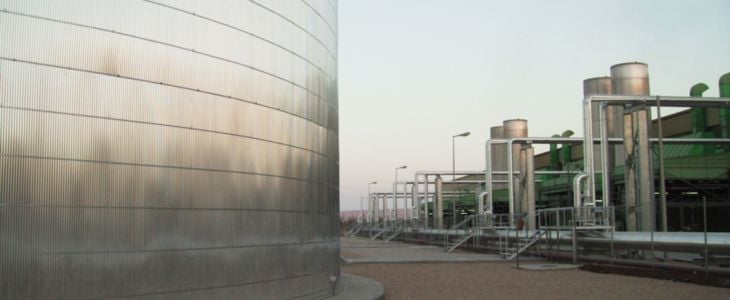In a context where increased efficiency has become a priority in energy generation processes, phase change materials for thermal energy storage represent an outstanding possibility.
Current research around thermal energy storage techniques is focusing on what techniques and technologies can match the needs of the different thermal energy storage applications, which range from district heating efforts, to industrial environments. In fact, thermal energy storage has become crucial in light of the impending transition towards renewable energy sources, as these tend to provide intermittent and thus unreliable power.
In light of growing interest in TES, phase change materials for thermal energy storage are more and more commonly used.
What are phase change materials for thermal energy storage
Phase change materials (PCMs) are materials that can undergo phase transitions (that is, changing from solid to liquid or vice versa) while absorbing or releasing large amounts of energy in the form of latent heat.
Essentially, all materials can be considered phase change materials, as they all transition states and absorb and release energy. However, the defining characteristic of PCMs is that they do so in an effective and predictable manner. Additionally, they present a high latent heat capacity, meaning they can absorb or release a large amount of energy compared to other materials in a relatively small space.
Because of this property, PCMs are being used for the storage of thermal energy as latent heat, being effectively able to preserve waste heat and other sources of heat energy.
A key benefit of using phase change materials for thermal energy storage is that this technique, based on latent heat, both provides a greater density of energy storage and a smaller temperature difference between storing and releasing heat when compared to the sensible heat storage method.
There are several materials that are considered as PCMs, their characteristics being increasingly investigated in order to incorporate them into thermal energy storage applications. Some of them include:
-
Inorganic systems (salt, salt hydrates and metal alloys)
-
Organic compounds (paraffins, fatty acids
-
Polymeric materials (polyethylene glycol
These present different temperature storage ranges and enthalpy energy storage characteristics. For instance, paraffins and salt hydrates are typically enough to guarantee thermal energy storage as incorporated in building materials; on the other hand, salts are used for storage at higher temperatures, such as the one needed in power plants.
How do phase change materials for thermal energy storage work
- Heat transfer processes between PCM and fluid cycles can take different shapes. On the one hand, there can be a direct contact between phase change material and heat transfer fluid. On the other hand, macroscopic capsules represent the most common method, using a neutral material for the capsule; finally, micro-encapsulation is also available, using a small shell
- The melting and solidification of PCMs must be understood in order to use them. These will dictate the operating temperature ranges available for the specific TES system. Generally, a high thermal stability is desired, so that high melting and solidification temperatures are preferred.
- PCMs typically need to be encapsulated to avoid leakages or contamination.
Advantages and disadvantages of PCM use compared to stratified water storage
The two main advantages of employing phase change materials for thermal energy storage include:
- PCMs present a higher latent thermal energy storage capacity, compared to the thermal energy storage capacity of water. In fact, PCMs can store more energy per unit mass compared to water. This allows for more compact.
On the other hand, they present three main disadvantages compared to conventional water storage:
- Higher up-front investment
- Because of their higher conductivity, PCMs can present a slower rate of heat transfer. This can have an impact in peak power scenarios when more discharge is needed
- More limited operational temperatures, which must be analyzed before implementing any structure
- Depending on the technology, usually they are less efficient and they consume higher energy that water tanks because cooling shall be produced at lower temperatures because the energy is not used directly but through a heat exchanger
For this reasons, usually stratified water thermal energy storage systems are preferred if there is space available.

The crucial role of Thermal Energy Storage (TES) and phase change materials in the future of decarbonization
The development of TES systems represents a key priority to realize the potential of renewable energy and progressing towards decarbonization.
In a context of climate change mitigation, the decarbonization of energy infrastructures is essential. However, this transition towards renewables needs to take into account how these sources tend to present low-grade profiles or be extremely intermittent. This is simply not feasible considering the current and expected growth of energy demand on a global scale.
Fortunately, new developments in heat energy engineering are able to solve these issues. While a new generation of highly efficient industrial heat pumps is able to solve the first issue, TES technologies stand out for their capacity to circumvent the intermittency issue.
Thermal Energy Storage (among which phase change materials are included) is able to preserve energy that would otherwise go to waste as both sensible or latent heat. This energy is then used when needed, such as peak periods, extending the capacities of power plants, such as turbine-based thermal power plants.
The result is a plant that is able to operate under constant conditions, even during peak demand periods and intermittent power production. This, in turn, translates into TES enabling energy savings for power plants and a maximized efficiency.
At ARANER, we’re able to provide the right design for a TES system considering each project’s needs and limitations. Factors such as space availability, load profile and operating characteristics will dictate our design of customized solutions, which may consider phase change materials for thermal energy storage.
Get in touch with us and find out how we can help you achieve the TES system that your project needs.










